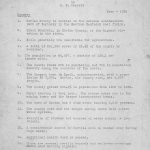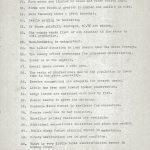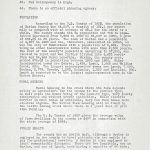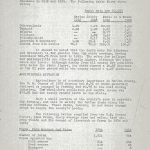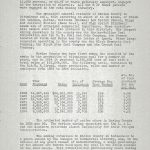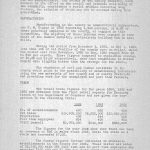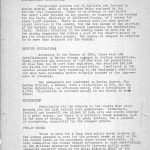Pine Mountain Settlement School
Series 18: PUBLICATIONS RELATED
1936 Excerpts from Preliminary Survey of
County Planning Problems
Harlan County, KY
By H.E. Barrett
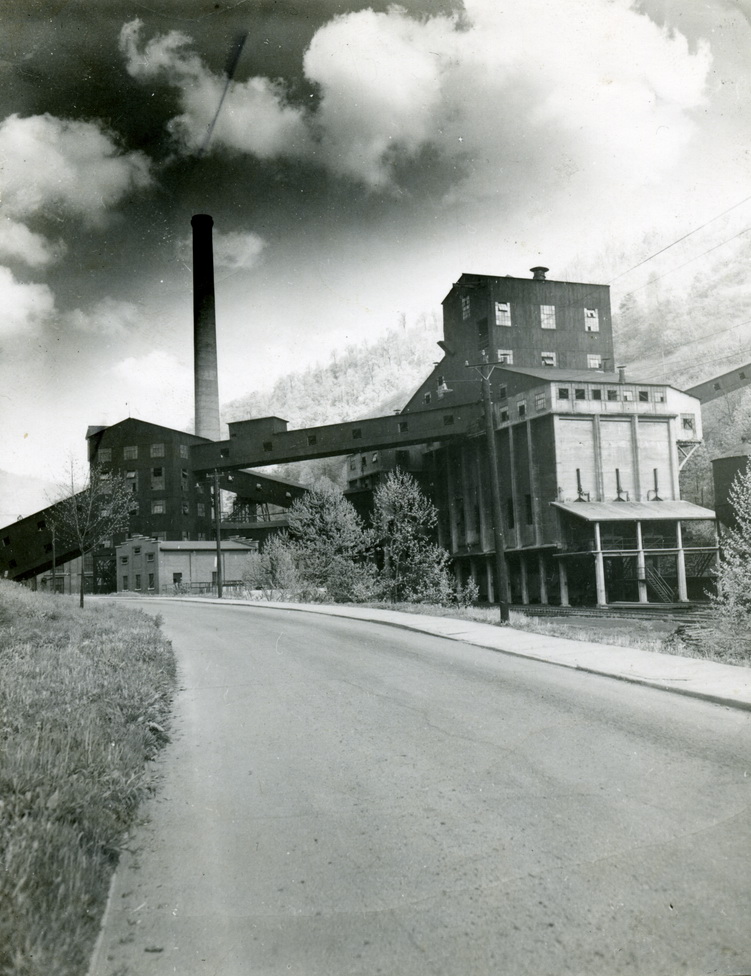
Joe Bramlett Album – Tipple in Harlan County, location unknown. (Photo by Arthur Dodd, filter used) [bram_-59.jpg]
TAGS: Studies, surveys,1936, Preliminary Survey of County Planning Problems Harlan Co Ky, H.E. Barrett, coal industry, population, rural housing, public health, agricultural situation, mineral situation, manufacturing, trade, professional occupations, service occupations, recreation, public works, sociology, statistics
PUBLICATIONS RELATED 1936 Excerpts from H.E. Barrett Preliminary Survey of County Planning Problems Harlan Co Ky
Glyn Morris was into his fourth year as Director of Pine Mountain Settlement School in 1936. It was a tumultuous time. Harlan County, Kentucky, was exploding in population. and it was under siege from many fronts. The Louisville Courier-Journal reported that in March of that year, there was a severe outbreak of spinal meningitis in Cumberland, in Benham, in Lynch, and in the town of Harlan. Assistance was requested from the State Board of Health which sent doctors and nurses to the area to quell the epidemic. Over twenty-five persons died in the initial stages of the outbreak. In fact, the health picture was so dire that a Federal health officer was called in to consult with local authorities. According to local news. it was reported that Federal medical personnel (described as surgeons} from Washington were sent to review the situation.
In a peculiar response, the National medical officers and Harlan county physicians called for the closure of all churches and theaters but advised that all schools were to remain open. Clearly, there was confusion on the part of the medical advisory and the county officials about the best course of action. There were strong indicators that no prior county planning was in place for local medical emergencies such as occurred in the county..
The following abbreviated survey outlines the key culprits in the County chaos during the county- wide emergency and points to potential surveys and remediation strategies that might have made the situation less chaotic.
Taken in 1936, this Preliminary Survey of County Planning Problems in Harlan County, Kentucky, reflects, in particular, the rapid growth of the coal industry and its impact on the county. The survey, commissioned by Berea College, contains vital statistics such as population, rural housing, public health, agricultural situation, mineral situation, manufacturing, trade, professional occupations, service occupations, recreation, and public works in Harlan County. A summary of 44 consideration points precedes the report.
TRANSCRIPTION: STUDIES SURVEYS 1936 Excerpts from Barrett Preliminary Survey of County Planning Problems Harlan Co Ky
01
Excerpts from
PRELIMINARY SURVEY OF COUNTY PLANNING PROBLEMS
IN HARLAN COUNTY, KENTUCKY
by H.E. Barrett
Summary Year – 1936
- Harlan County is located in the extreme southeastern part of Kentucky in the Eastern Kentucky coal fields.
- Black Mountain, in Harlan County, is the highest elevation in the state.
- Soils generally are unsuitable for agriculture.
- A total of 261,260 acres of 85.4% of the county is woodland.
- The population is 64,557, a density of 135.1 per square mile.
- The county ranks 5th in population and 7th in population density among the counties of the state.
- The largest town is Lynch, unincorporated, with a population of 7,000. Harlan, the county seat, has 4,327 people.
- The county gained 556.2% in population from 1900 to 1930.
- Rural housing is very poor. The better homes are in the mining towns and the larger incorporated towns.
- The town of Harlan has 6 slum areas housing 2,216 persons.
- The county seat and the larger mining towns have modern water systems.
- Pollution of streams and sources of water supply is prevalent.
- A considerable amount of fertile soil is washed away during high water.
- Additional health work is needed.
- There are several traffic hazards and railroad crossings which need warning signals..
- Agriculture is of secondary importance.
02
- Farm areas are limited to creek and river bottom land.
- Farms are becoming greater in number and smaller in size.1
- Farm tenantry shows a great increase.
- Cattle raising is increasing.
- Of those gainfully employed, 60.7% are miners.
- The county ranks first of all counties in the state in coal production.
- Manufacturing is unimportant.
- The relief situation is less severe than the state average.
- The county offers advantages for increased manufacturing.
- Trade is on the upgrade.
- Retail trade covers a wide area.
- The ratio of professional men to the population is lower than in the state generally.
- Service occupations are adequate for present needs.
- Little has been done toward timber conservation.
- Large losses are sustained each year by fire.
- Scenic beauty is above the ordinary.
- Kentenia State Forest is available for recreation.
- County roads are in bad condition.
- Excellent railway facilities are available.
- Additional recreational facilities and plans are needed.
- Public works future planning should be undertaken.
- County institutions are in good condition.
- There is very little rural electrification except in mining camps.
- Illiteracy is above the state average.
- Bad roads are retarding county school consolidation.
03
- Development of 4-H Club work is being forwarded rapidly.
- Tax delinquency is high.
- There is no official planning agency.
POPULATION
According to the U.S. Census of 1930, the population of Harlan County was 64,557, a density of 135.1 per square mile as compared with an average of 65.1 for the state as a whole. The county stands 5th in population and 7th in population, increased from 9,838 in 1900 to 64,557 in 1930, a gain of 556.2% in 30 years. The town of Harlan had a population of 4,327 in 1930 and was, therefore, classified as urban, as was the city of Cumberland with a population of 2,639. There being no other incorporated towns with more than 2,500 people, the rest of the county’s population amounting to 57,591, was classed as rural and was further divided into 4,623 rural- farm and 52,968 rural non-farm. Harlan, the county seat, gained 676.8% in population between 1900 and 1930. Other incorporated towns are Evarts, 1,438, Loyal, 1,468, and Wallins Creek, 900. The largest unincorporated towns are Lynch, 7,000, Benham, 2,779, Kenvir, 1,500, Lejunior, 1,000 and Louellan, 900. Lynch is reported to be the largest unincorporated town in the United States.
RURAL HOUSING
Rural housing in the areas where the farm depends solely on agriculture for its income is the poorest type, in most cases the homes being of the lean-to type, very poorly constructed and without proper sanitation. While electric service in most cases is available, very few farm homes have electric lights. The better farm housing will be found in the active mining areas where there is a great deal of part-time farming.
The U. S. Census of 1930 gives the average value of farm dwellings in the county as $497 in comparison with the state average of $664.
PUBLIC HEALTH
The county has no health unit, although a doctor is employed by the county to treat patients who are unable to pay for professional service. A doctor is also employed to treat communicable diseases. There are two hospitals, one at Harlan, and one at Lynch, each having a capacity of 50 beds.
04
The county death rate is considerably lower than that for the state, as borne out by data in the Preliminary Report of the State Planning Board of Kentucky, issued in 1934, and showing comparative death rates for significant diseases in 1912 and 1933. The following table shows these rates:
|
Death rate per 10,000 |
||||
|
Harlan County |
State as a Whole |
|||
|
1912 |
1933 |
1912 |
1933 |
|
|
Tuberculosis |
5.59 |
5.25 |
20.56 |
8.39 |
|
Typhoid |
0.93 |
1.02 |
3.32 |
1.2 |
|
Malaria |
— |
— |
0.77 |
0.29 |
|
Pellagra |
— |
1.24 |
0.49 |
0.48 |
|
Poliomyelitis |
— |
0.17 |
0.16 |
0.11 |
|
Diarrhea & Dysentery |
1.86 |
12.4 |
6.45 |
5.26 |
|
Deaths from All Causes |
72.7 |
76.0 |
129.01 |
106.0 |
It should be noted that the death rate for diarrhea and dysentery is far greater than the state average, having increased 566.7% from 1912 to 1933. The rates for pellagra and poliomyelitis are also slightly higher, although the other rates are lower. Although deaths from all causes are considerably below the state figure, the state showed a 16.3% decrease in the 21-year period while the county showed a 4.5% increase.
AGRICULTURAL SITUATION
Agriculture is of secondary importance in Harlan County, the U. S. Census of 1930 showing but 6.7% of those gainfully employed as engaged in farming and 60.7% in the coal mining industry. The rural-farm population per capita income was $79.83 and the county ranked 110th in the state.
Only a small portion of the county’s area is suitable for farming, and this is mainly the bottom lands along the various streams. These farms, however, do not raise enough crops to supply the county’s needs.
The following tables compiled from the U.S. Census Report, show farms, their average size and value, land use, crop yields and the amount of livestock on farms in 1934 and 1929:
|
Farms, Farm Acreage, and Value |
||
|
1934 |
1929 |
|
|
Number of farms |
1,815 |
786 |
|
Farms operated by: Full owners Part owners Managers All tenants Croppers |
814 318 — 683 75 |
451 56 3 276 7 |
|
Value of farms, land, & buildings |
$1,711,719.00 |
$2,422, 086.00 |
|
Average value per farm |
$943.00 |
$3,082.00 |
|
Average value per acre |
$20.25 |
$41.70 |
|
All land in farm (acres) |
84,516 |
58,088 |
|
Average acreage per farm |
46.6 |
73.9 |
05
The U. S. Census of 1930 reported that there were 11,685 persons, or 60.7% of those gainfully employed, engaged in the extraction of minerals. All but 8 of these persons were engaged in the coal mining industry.
The principal mineral resource of Harlan County is bituminous coal, this occurring in about 12 to 15 seams, of which the Imboden, Harlan, Kellioka (Keokee) Low Splint (Mason, Mingo and Jellico) Wallins (Dean No.4), and High Splint (Hindman) seams are of principal commercial importance. Some considerable cannel coal is also produced in this district. The largest mining operators in the county are the Harlan-Wallins Coal Corporation and the U. S. Coal and Coke Company, the former located at Verda and Molus and the latter at Lynch. Other large companies operating in the county are the Black Mountain Coal Company, the Black Star Coal Company, and the Creech Coal Company.
Harlan County has been first among the counties of the state in the production of bituminous coal for a number of years, and in 1934 it produced 9,532,303 tons of coal with a total value of $16,246,000. The following table, furnished by the L. & N. Railroad, shows production, value and number of employees from 1928 to 1934 inclusive.
|
Bituminous Coal Production |
|||||
|
Year |
Tons Produced |
Value |
No. of Employees |
Average No. Days Worked |
Av. No. of tons produce per man per day |
|
1928 |
14,427.444 |
$25,531,000 |
11,189 |
259 |
4.98 |
|
1929 |
14,093,453 |
24,432,000 |
10,831 |
259 |
5.02 |
|
1930 |
12,742,062 |
20,907,000 |
11,920 |
214 |
4.98 |
|
1931 |
9,338,951 |
13,598,000 |
9,932 |
175 |
9.40 |
|
1932 |
6,888,875 |
7,765,000 |
7,838 |
156 |
5.63 |
|
1933 |
8,831,005 |
11,118,000 |
8,958 |
182 |
5.41 |
|
1934 |
9,582,303 |
16,246,000 |
10,705 |
206 |
4.35 |
The estimated number of active miners in Harlan County in 1934 was 98. The various mining operators use the L. & N. and the Southern railroads almost exclusively for their freight transportation.
The mining situation in Harlan County is influenced to a great extent by the changes in industrial activity, and, in the absence of any great amount of manufacturing, a large percentage of the miners are thrown back upon the soil in the slack seasons at the coal mines. This situation was particularly acute during the years of 1931 and 1933, inclusive, when production at the mines reached its lowest ebb in the past decade. Although production was considerably higher in 1934 than for the three pre-…
06
…ceding years, there is still need for constructive planning to aid the miner-farmer. The status of the mining industry, with respect to its effect on the social and economic well being of the community, constitutes a social problem involving many factors, the solution of which may not be reached during this generation.
MANUFACTURING
Manufacturing in the county is comparatively unimportant, the U. S. Census of 1930 reporting 1,140 persons, or 5.9% of those gainfully employed in the county, as engaged in this occupation. The majority of these persons were engaged in some phase of the lumber industry, particularly building and in sawmills.
During the period from December 1, 1933, to May 1, 1934, less than 10% of all families of the county were on relief, while the relief cost from November, 1932 to May, 1934 ranged from $8 to $10 per capita. These figures compared to state-wide average of 15.0% and $9.49 respectively, show that conditions in Harlan County were slightly better than the average for the state.
The abundance of coal and timber available in the county would point to the possibility of establishing industries using the raw materials of the county and of nearby districts and providing work for the unemployed and part time farmers.
TRADE
The retail trade figures for the years 1929, 1933, and 1935 are obtained from the final retail reports for Kentucky. issued by the Department of Commerce and are given for comparison in the following table:
|
Retail Trade |
|||
|
1929 |
1933 |
1935 |
|
|
No. of establishments |
490 |
362 |
409 |
|
Net sales |
$15,503,000 |
$6,205.000 |
$10,239,000 |
|
Proprietors |
493 |
344 |
348 |
|
Full time employees |
854 |
496 |
954 |
|
Total payroll |
$1,074,000 |
$515,000 |
$839,000 |
The figures for the year 1936 show that there has been an increase of 65% in sales since 1933, while the state as a whole has increased 27.5%.
The Census figures further indicated 15 wholesale establishments in the county for 1933. These listed net sales of $2,162,000 with 123 full time and 10 part time employees who received $122,000 and $1,000 for their services respectively.
The retail trade area covers the entire county and part of Bell, Leslie, Perry, and Letcher counties and a small part of the State of Virginia. Trade in the mining towns is more often with the company owned stores.
07
PROFESSIONAL OCCUPATIONS
Forty-eight doctors and 11 dentists are located in Harlan County, most of the doctors being employed by the various coal companies. There is an average of one doctor for every 1,345 persons in the county, as compared to an average for the state, exclusive of Jefferson County, of 1 doctor for every 1,107 persons. There is evident need for more professional services in the county, but the low income of the majority of the workers does not tend toward increasing the professional field. Medical attention in the mining towns is paid for by the mining companies who retain a part of the miner’s salary to pay for attention when needed. The number of lawyers is reported to be more than adequate for the demand.
SERVICE OCCUPATIONS
According to the Census of 1933, there were 104 establishments in Harlan County engaged in service occupations. These reported net receipts of 167,245 with 114 proprietors, 49 full time and 24 part time employees, who received $32,602 and $4,954 for their services respectively. Conditions in the service occupations vary according to the employment conditions and have been decidedly better recently because of the improvement in industry.
Two newspapers are published in Harlan County, The Harlan Courier, a weekly, with a circulation of 500, and the Harlan Enterprise, an afternoon daily, with a circulation of 2,700. Circulation is confined mainly to the county in both cases.
RECREATION
Practically all the schools in the county have playgrounds and the high schools have gymnasiums. Basketball, football, and baseball are played in both city and county schools to a great extent, and there is a privately owned swimming pool in the town of Harlan. There is need, however, for a planned [program] of recreation, especially for the younger people.
PUBLIC WORKS
There is need for a long term public works program in the county planned to care for the present needs as well as for the future needs as the necessary funds become available. In this connection the county should co-operate in such undertakings as the National Resources Committee’s six-year public works inventory recently taken by the State Planning Staff of the Governor’s Cabinet.
End
GALLERY – 1936 Excerpts from the H.E. Barrett Preliminary Survey of County Planning Problems Harlan Co., Ky
- 01 barrett_harlan_survey_01
- 02 barrett_harlan_survey_02
- 03 barrett_harlan_survey_03
- 04 barrett_harlan_survey_04
- 05 barrett_harlan_survey_05
- 06 barrett_harlan_survey_06
- 07 barrett_harlan_survey_07
See Also:
BIBLIOGRAPHY Harlan County Kentucky
Return To:
PUBLICATIONS RELATED GUIDE

